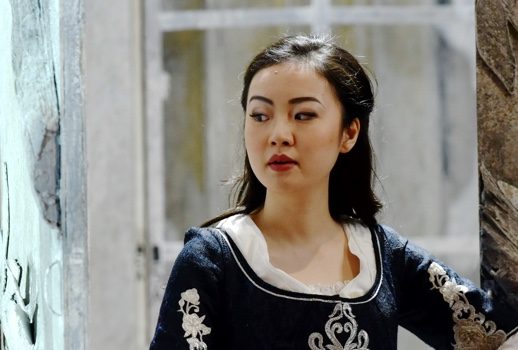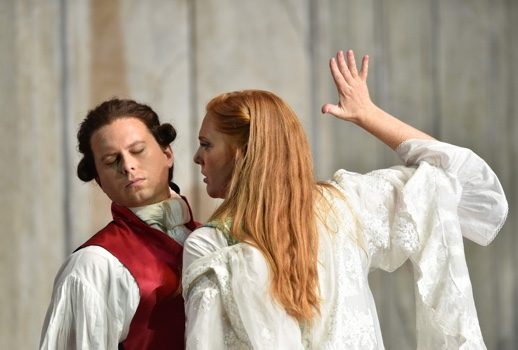

Ying Fang provided the biggest reward in this presentation. She was an irresistible Susanna. She has a crystalline voice of striking loveliness projected effortlessly. Her phrasing and rhythm were perfect, her Italian was the best of anyone’s in the cast. She has an enticing presence, was game in coping with the nonsensical stage business she was given but had an infectious wit that was all her own. Only at a few moments did she seem a little light for this long role, but there was abundant promise of her voice blossoming into a gorgeous full lyric soprano.
Two other singers had good nights. Ashley Milanese was an adorable Barbarina with a beautiful voice and great charm who made the most of every moment she was given. As the Count, John Chest, displayed an impressive high baritone, of beautiful quality and real thrust at the top. The role may have been a little low for him, yet he coped with its difficult moments, including that killer aria, with impressive technical aplomb.
David Devan, the company’s General Director started the evening by announcing that Cecilia Hall, the Cherubino, had been battling a bad cold. But she did the part capably, coping with those two beloved but difficult arias efficiently, and executing all the forced slapstick with spirit. One did wonder about two other leading singers who were not announced as ill but sounded like they might be.
Brandon Cedel, Figaro, a gifted baritone in the recent past, could not seem to bring his voice into good focus, and had some difficulties at both ends of his range. Layla Claire, The Countess, another singer of considerable achievement, likewise seemed to struggle. She sang flat a good deal, both in her arias, and crucially, unfortunately, in those magical phrases where the Countess forgives the Count, “Piu docile sono e dico di si…” One could see her trying to float her beautiful sound out into the house and not succeeding. (Did they have a lottery backstage to see who got to announce being sick?)
Lucy Schaufer and Patrick Carfizzi were seasoned pros as Marcellina and Don Bartolo. Poor Jason Ferrante was saddled with both the most obnoxious conception of Don Basilio I’ve ever seen plus a supremely awkward way he could double Don Curzio. He did his best to cope.
Corrado Rovaris conducted from the harpsichord and allowed the proper musical grammar in recitatives, tasteful cadenzas and a certain amount of decoration in arias. But although these musicians must have been many of those from the outstanding Tancredi of two months ago, they did not play with the same unanimity or distinction. There was sour, poorly blended wind tone and rather loose ensemble. Rovaris, after his superbly conceived Tancredi was back to rushing everything. There is good reason for a lively approach but not to the point of obscuring the theatrical character of the music.
“Non piu andrai,” for example, although it’s marked allegro vivace, is a rondo that becomes a march, and speeding through robbed it entirely of its mock military character. Moreover( although Rovaris can’t be blamed for this), the effect of the joking martial postlude, a tribute to the incongruity of Cherubino, a teenager of ambiguous gender, as a mustachioed soldier dodging bullets, was wrecked when the lights went out during it for a scene change! That was profoundly unmusical.
One also has to wonder what was gained in rushing through the letter duet so fast that the byplay between the ladies was lost. It is marked allegretto and so beautiful with its oboe, bassoon and string accompaniment that it always works a spell—except here.
The finale of act two—one of the most astounding long Mozart finales with its phenomenal organization and superb overall arc punctuated by smaller sections in different tempos—was such a blur that the singers struggled to keep up and none of the wit or the dramatic complexity of the many small sections was captured.
Of course it’s possible that Rovaris hated the production and just wanted to get it over with. A co-production with Lyric Opera of Kansas City, San Diego Opera and Palm Beach Opera, I suppose Opera Philadelphia could duck significant responsibility for this ugly mess.
The director, Stephen Lawless, reduced this complex and very human story to a sitcom with mindless hyperactive business resembling nothing that humans do.

The Count is a provincial autocrat who rules by whims. These are forestalled or implemented by the carefully managed intrigues of servants and hangers on. The servants all take big risks in defying the master. The stakes are huge.
The Countess Rosina has used her fortune as a dowry to marry the Count, who she loves. She has traded her independence for a title and the man she wants but she is entirely at his mercy. When he tells her to get out she is in real jeopardy in a society where there is no divorce and no way for a woman to support herself easily. That she defends herself angrily and with dignity goes to her character—but that went for nothing here.
The Count and Figaro were friends when the Count was wooing Rosina. But Figaro also has traded his independent life that for what he imagined would be a stable, rising position with an ambitious aristocrat—a better situation in which to marry and start a family. But he too is merely a servant, easily dismissed, and the girl he loves is desired by the Count. As in all feudal societies Susanna has a kind of servant status. Her family has been on the estate forever, and that is the source of her identity and self-worth.
Although Le Nozze di Figaro is meant to be very funny on the way to ending well for all, the tension and risk are always there and that (eventual) happy ending can never be taken for granted.
Lawless had Susanna and Figaro’s bedroom in a hallway (not “the best room in the Palace” as the perhaps optimistic Figaro describes it) lit by big chandeliers! The only furniture is a bed. Naturally their enemies climb into it with shoes that would have been caked with filth—as though anyone would violate a couples’ marital bed the day of their wedding!
When first Cherubino and then the Count hide they had to get under and behind the bed. One of the most naturally (and easily) hilarious scenes in opera turned into a confusing mess.
In act two there were lock noises for some of the doors, but not one for the closet in which Cherubino—in real danger from the count—hides. When Susanna hid there herself, there was no locking noise and the Count stood with his pry tools when she simply opened the door, ruining one of the funniest entrances in opera.
Much play is made of the distance Cherubino will fall when he jumps out the window, but a little while later Antonio climbs up the wall and into the room. How is that possible for an old drunk unless the room is close to the ground? Perhaps worst of all, the momentarily reconciled Count and Countess made out out on her bed—in front of her servant, Susanna!
In act three the chorus used their fandango celebratory dance to menace the Count. Why? The French revolution is years away; meanwhile, no servant on his estate would have threatened the Count to his face without being horsewhipped and sent on his way to beggary.
Worse, in act four, the last scene was played not “among the pines in the garden” but in a courtyard where it looked like the façade of the palace had been vandalized. But who would pick the wedding day of Susanna and Figaro for such a demonstration? As the folle journée drew to its close, the cast righted a few pieces of overturned furniture and sat down, just as though nothing had happened!
I only hope the standing ovation at the end of the performance was for Mozart’s music, and not for the mindless antics onstage, Figaro deserves better than to be treated like an episode of Keeping Up with the Kardashians.
Photos: Kelly & Massa for Opera Philadelphia.

























Comments